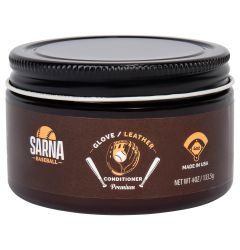How to Oil a Baseball & Softball Glove: A Step-by-Step Guide

Regularly oiling and conditioning a baseball or softball glove is essential for maintaining its flexibility, durability, and overall performance. Leather gloves can become dry and stiff over time, leading to cracks and reduced responsiveness on the field. Applying a proper glove oil or conditioner helps keep the leather soft, prevents excessive wear, and extends the glove’s lifespan. However, moderation is key—over-oiling can make the glove heavy and break down the leather. By using the right products and conditioning the glove periodically, players can ensure their glove remains game-ready and comfortable for seasons to come.
In this article, we will cover:
Preparing Your Glove for Oiling
- Gather Your Materials – You’ll need a soft, dry cloth, a mild leather cleaner or warm water with a small amount of soap, and a soft brush or sponge. Avoid harsh chemicals that can damage the leather.
- Remove Dirt and Debris – Use the dry cloth or brush to wipe away dust, dirt, and excess debris from the glove, especially in the creases and laces.
- Clean with a Damp Cloth – Lightly dampen a cloth or sponge with warm, soapy water and gently wipe down the glove’s surface. Avoid soaking the leather, as too much moisture can cause stiffness.
- Wipe Off Excess Moisture – Use a clean, dry cloth to remove any remaining soap or moisture, ensuring the glove is not too wet before conditioning.
- Let the Glove Air Dry – Place the glove in a cool, dry place and allow it to air dry completely before applying oil or conditioner. Avoid direct sunlight or heat sources, which can dry out the leather.
Once the glove is clean and dry, it’s ready for oiling, which will help restore its softness and keep it in peak condition.
How to Apply and Use Glove Oil
- Choose the Right Oil or Conditioner – Use a glove-specific oil or conditioner, such as lanolin-based products or mink oil. Avoid petroleum-based oils, which can break down the leather.
- Use a Small Amount – Apply a dime-sized amount of oil to a clean, soft cloth or sponge. Too much oil can make the glove heavy and weaken the leather over time.
- Focus on Key Areas – Gently rub the oil into the glove’s palm, pocket, and webbing, as these areas experience the most wear and need the most flexibility.
- Apply to the Laces (Optional) – Lightly oil the laces to prevent them from drying out and becoming brittle, but avoid over-saturating, as it can cause stretching.
- Work the Oil Evenly – Use circular motions to spread the oil evenly across the leather, ensuring it absorbs properly without leaving excess residue.
- Let the Glove Rest – Allow the glove to sit in a cool, dry place for several hours or overnight to let the oil fully absorb. Avoid placing it in direct sunlight or near a heat source.
- Wipe Off Excess Oil – After the oil has settled, use a clean cloth to remove any leftover residue, ensuring the glove isn’t too greasy or slippery.
- Break in the Glove – After conditioning, work the glove by playing catch, shaping the pocket, or using a mallet to help it regain flexibility and maintain its form.
Following these steps will keep the glove well-conditioned, soft, and game-ready for an extended lifespan.
Glove Shaping and Conditioning
- Let the Glove Rest – Place the glove in a cool, dry area and allow it to sit overnight so the oil fully absorbs into the leather. Avoid direct sunlight or heat, as it can dry out the glove.
- Remove Excess Oil – After resting, use a clean cloth to wipe away any leftover oil to prevent the glove from feeling greasy or heavy.
- Shape the Glove with a Ball – Place a baseball or softball in the pocket, close the glove around it, and secure it with a rubber band or wrap to help form a natural catching shape.
- Use a Mallet for Extra Flexibility – Gently pound the pocket and hinge area with a glove mallet to soften the leather and create a deeper, more flexible pocket.
- Play Catch to Work It In – Regular use is the best way to break in the glove after oiling. Play catch or repeatedly open and close the glove to maintain its flexibility.
- Store Properly – When not in use, keep the glove in a cool, dry place with a ball in the pocket to help it maintain its shape. Avoid leaving it in a hot car or damp areas that can damage the leather.
How Often Should You Oil a Baseball & Softball Glove
| Usage Level | Oiling Frequency | Notes |
| New Glove (Break-In Period) | Light application every 2-3 weeks until fully broken in | Helps soften the leather and speed up break-in without over-saturating |
| Regular Use (Weekly Play) | Every 2-3 Months | Maintains flexibility and prevents the leather from drying out |
| Occasional Use (Few Times a Month) | Every 4-6 Months | Keeps the glove conditioned while preventing excessive oil buildup |
| Offseason Storage | Before and after Storage | Apply a light coat before storing and again before the next season to keep the leather supple |
| Dried-Out or Cracking Leather | As needed, in small amounts | Apply oil in thin layers until the leather regains flexibility. Avoid over-conditioning |
Baseball & Softball Glove Oil Alternatives
| Type of Oil | Benefits | Drawbacks | Best For |
| Glove-Specific Oil (Rawlings, Wilson, Nokona) | Designed specifically for gloves, prevents drying and cracking | It can be more expensive than natural alternatives | The best overall choice for maintaining glove leather |
| Mink Oil | Softens and conditions leather provides water resistance | Can darken leather and overuse may weaken the glove over time | Players who need extra moisture protection |
| Neatsfoot Oil | Deeply conditions and restores dried-out leather | Can over-soften leather if applied too often | Older gloves needing restoration |
| Lanolin-Based Conditioners | Keeps leather supple while maintaining durability | Some brands can be greasy or leave residue | Regular glove maintenance |
| Shaving Cream (with Lanolin) | Readily available and helps soften leather | Not as effective as dedicated glove oils | Quick and light conditioning |
| Coconut Oil | Natural, lightweight, and won’t over-soften leather | Doesn’t provide deep conditioning or long-lasting moisture | Minor touch-ups and eco-friendly option |
| Petroleum-Based Oils (Vaseline, Motor Oil, etc.) | Waterproofs and softens | Breaks down leather fibers, making the glove weaker over time | Not recommended |
How To Oil a Baseball & Softball Glove - Frequently Asked Questions
Is mink oil good for baseball gloves?
- Yes, mink oil is good for softening and conditioning leather, but overuse can weaken the glove and darken the leather over time. It’s best used sparingly for moisture protection.
What kind of oil should I use for an old baseball glove?
- Neatsfoot oil or a lanolin-based glove conditioner works best for restoring dried-out leather, as they deeply moisturize without over-softening.
How do I oil a catcher’s mitt differently from other gloves?
- Apply oil more sparingly to a catcher’s mitt, focusing on the pocket and hinge while avoiding excessive oil on the padding to maintain structure and durability.
Can too much oil damage my glove?
- Yes, over-oiling can make the glove heavy, weaken the leather fibers, and reduce its lifespan by breaking down the material.
What oil to use to break in a baseball glove?
- A small amount of glove-specific oil, lanolin-based conditioner, or mink oil helps soften the leather without over-saturating it during the break-in process.











